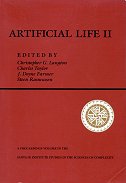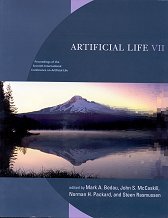The papers are gathered under the following headings: • Overview • Origin/Self-Organization • Evolutionary Dynamics • Development • Learning and Evolution • Computation • Philosophy/Emergence • The Future
Contents
- • Thomas S. Ray. An Approach to the Synthesis of Life. 1992
- A description of his virtual Tierra environment, for studying artificial open-ended evolution
- • Christopher G. Langton. Introduction to Artificial Life II. 1992
- • Charles E. Taylor. "Fleshing Out" Artificial Life II. 1992
- • Christopher G. Langton. Life at the Edge of Chaos. 1992
- • Richard J. Bagley, J. Doyne Farmer. Spontaneous Emergence of a Metabolism. 1992
- • Richard J. Bagley, J. Doyne Farmer, Walter Fontana. Evolution of a Metabolism. 1992
- • Walter Fontana. Algorithmic Chemistry. 1992
- • Steen Rasmussen, Carsten Knudsen, Rasmus Feldberg. Dynamics of Programmable Matter. 1992
- • Maarten Boerlijst, Paulien Hogeweg. Self-Structuring and Selection: Spiral Waves as a Substrate for Prebiotic Evolution. 1992
- • Peter Schuster. Complex Optimization in an Artificial RNA World. 1992
- • Kristian Lindgren. Evolutionary Phenomena in Simple Dynamics. 1992
- • W. Daniel Hillis. Co-Evolving Parasites Improve Simulated Evolution as an Optimization Procedure. 1990
- • Stuart A. Kauffman, Sonke Johnson. Co-Evolution to the Edge of Chaos: Coupled Fitness Landscapes, Poised States, and Co-Evolutionary Avalanches. 1992
- • David G. Stork, Bernie Jackson, Scott Walker. "Non-Optimality" via Pre-Adaptation in Simple Neural Systems. 1992
- • Mark A. Bedau, Norman H. Packard. Measurement of Evolutionary Activity, Teleology, and Life. 1992
- • Martin J. de Boer, F. David Fracchia, Przemyslaw Prusinkiewicz. Analysis and Simulation of the Development of Cellular Layers. 1992
- • David H. Ackley, Michael L. Littman. Interactions Between Learning and Evolution. 1992
- • Richard K. Belew, John McInerney, Nicol N. Schraudolph. Evolving Networks: Using the Genetic Algorithm with Connectionist Learning. 1992
- • David R. Jefferson, Robert J. Collins, Claus Cooper, Michael G. Dyer, Margot Flowers, Richard Korf, Charles E. Taylor, Alan Wang. Evolution as a Theme in Artificial Life: The Genesys/Tracker System. 1992
- • Robert J. Collins, David R. Jefferson. AntFarm: Towards Simulated Evolution. 1992
- • John R. Koza. Genetic Evolution and Co-Evolution of Computer Programs. 1992
- • Bruce J. MacLennan. Synthetic Ethology: An Approach to the Study of Communication. 1992
- • Gregory M. Werner, Michael G. Dyer. Evolution of Communication in Artificial Organisms. 1992
- • Edwin Hutchins, Brian Hazlehurst. Learning in the Cultural Process. 1992
- • Alvy Ray Smith. Simple Nontrivial Self-Reproducing Machines. 1992
- • Eugene H. Spafford. Computer Viruses--A Form of Artificial Life?. 1992
- • Elliott Sober. Learning from Functionalism--Prospects for Strong Artificial Life. 1992
- • Steen Rasmussen. Aspects of Information, Life, Reality, and Physics. 1992
- • Peter Cariani. Emergence and Artificial Life. 1992
- • Louis Bec. Elements d'Epistemologie Fabulatoire. 1992
- [in French]
- • J. Doyne Farmer, Alletta d'A. Belin. Artificial Life: The Coming Evolution. 1992



